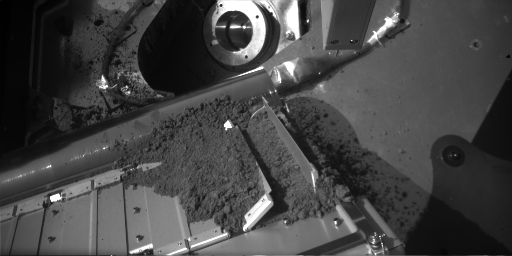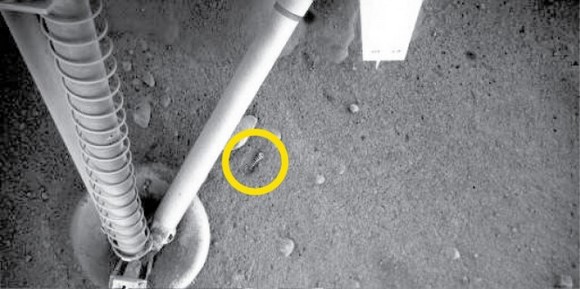Phoenix “vibrates” to move soil through a screen.
New motto for the Phoenix spacecraft: If at first you don’t succeed, then dust yourself off and try again. Since the Martian soil is proving to be a challenge for the Mars lander, engineers will try a new technique to try delivering the frozen arctic soil into the TEGA, or the Thermal and Evolved-Gas Anaylzer, designed to bake and sniff samples to identify key ingredients in the soil. The soil is clumping together, and won’t pass through a screen that brings it to the ovens on board the spacecraft. Engineers operating the Robotic Arm on Phoenix Lander are testing a revised method they are calling the sprinkle technique.
“We’re a little surprised at how much this material is clumping together when we dig into it,” said Doug Ming a Phoenix science team member from NASA’s Johnson Space Center, Houston.
Engineers commanded the spacecraft to vibrate the screen for 20 minutes on Sunday but detected only a few particles getting through the screen, not enough to fill the tiny oven below.
“We are going to try vibrating it one more time, and if that doesn’t work, it is likely we will use our new, revised delivery method on another thermal analyzer cell,” said William Boynton of the University of Arizona, lead scientist for the instrument.
The arm delivered the first sample to TEGA on Friday by turning the scoop over to release its contents. The revised delivery method, which Phoenix is testing for the first time today, will hold the scoop at an angle above the delivery target and sprinkle out a small amount of the sample by vibrating the scoop. The vibration comes from running a motorized rasp on the bottom of the scoop.
Phoenix used the arm Sunday to collect a soil sample for the spacecraft’s Optical Microscope, so look for images of that procedure soon. Today’s plans include a practice of the sprinkle technique, using a small amount of soil from the sample collected Sunday. If that goes well, the Phoenix team assembled at the University of Arizona plans to sprinkle material from the same scoopful onto the microscope later this week.
The Phoenix team also discussed this picture, showing a spring on the ground near a footpad of the spacecraft. It came from Phoenix itself, when the biobarrier was opened to free the robotic arm back on May 30, the sixth Martian day of the mission.



wow, such a trivial shortcoming of this fantastic machine. Hopefully it wont bring down the whole mission though. Who can now still argue that humans are not a valuable asset to have in space along side robots?
So I’m thinking…you have a frozen soil, and you blast it with the ‘retro-rockets’ on landing…isn’t that obviously going to blow all of the loose or sandy soil a great distance from the lander’s position given the lower gravity on Mars? And you are surprised by the fact that what is left under the Pheonix is “clumpy’? Just maybe the heat and the force of the blast did a little ‘freeze-thaw’ cycle, and that’s why the samples are sticking together.
Hopefully we haven’t shot ourselves in the foot without thinking this through.
I’m sure they’ll figure it out and get the results that they’re after, but I must say I was a little surprised that they didn’t have a little grinder or de-clumpifier (that’s the scientific term) on board that then fed into the instruments. Hindsight is 20/20 and all that I guess.
It’s bloody-well torture waiting for this thing to bake some samples!
Ok, a spring fell out onto the Martian soil. So… where did it come from? What aspect of operations will it effect? This is like putting a tricycle together and having a part left over. Oye vay.
Static electricity makes stuff clumpy. Moisture makes stuff clumpy.
Following on from Mags’ comment:
Is it possible that the soil is so ‘wet’ that it melts upon coming into contact with the mesh – which might have been heated by the sun – only to rapidly refreeze and gum up the works?
What time of day have they done the vibrating on? If freezing is the issue perhaps doing it at high noon – or in the afternoon, if Martian weather is a akin to ours – will be the ticket.
This is just “Murphy’s Law” jinx mode rearing its ugly head temporarily …….I hope.
Next time thy should include an expandable telescopic arm which unfolds to a distance far enough to see the big picture of the Phoneix itself to inspect it from all angles for missing parts etc.
It could also detect Martian gremlins doing their malicious work.
And , even better include a few humans on board….
It’s a static charge I tell ya! I suggested this when I first viewed the scoop with its “clinging dust”. Vibrating the sample will only increase the “static cling”. Worse, if I’m right it will affect the analysis. Possible solutions: a). Bang the sample somehow to possibly discharge the static charge. Or b). Dispense it without the sieve – however, this would tend to favor analysis of large clods over the clinging dust. Problems, problems…..
Why don’t they think about sending Asimo up there on a mission? He could be invaluable as a robot assistant for problems like these.
I’m sure there’s a good reason but anyone can tell me why they didn’t use a Gamma Ray Spectrometer to detect the composition of the soil ?
I don’t understand the advantages of the good ol’ method of burning the stuff up to know what its made of.
Any clue ?
Coz the good ‘ol way of doing this is a lot lighter in terms of the load u need to carry. I don’t think they could whack in a gamma ray spectrometer and have it come in at a few kgs.
Also, in reguards to the static cling dispersion method of “bang it on something”. The lander is made of metal so the soil will be already grounded and banging it on something will do nothing.